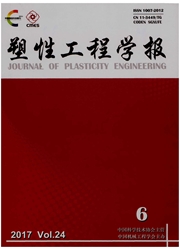

 中文摘要:
中文摘要:
晶界弹粘塑性变形损伤是钛合金超塑性成形和等温时效成形过程中的主要变形机制。文章考虑晶界的粘滞性及由其引起的率敏感性,建立弹粘塑性的晶界变形损伤本构模型,并结合Cohesive晶界单元描述晶界在钛合金低应变速率变形中的响应,实现对钛合金晶界的粘滞性滑移与迁移的合理描述。基于 ABAQUS/Explicit平台,利用所建模型对不同应变速率10-3 s-1、10-2 s-1和10-1 s-1下工业纯钛 T A1单向拉伸过程中的晶界滑移行为进行有限元数值模拟分析。结果表明,当晶界厚度由0.8μm增大至1.2μm时,其临界强度降低,且晶界滑移对塑性变形的贡献增大近两倍;当应变速率为10-2 s-1和10-3 s-1、对应塑性应变为0.1时,晶界滑移对塑性应变的贡献分别是应变速率为10-1 s-1时的10倍和20倍。
 英文摘要:
英文摘要:
It is recognized that the elastic-viscoplastic deformation and damage of grain boundary are the main modes in superplas-tic forming and isothermal aging of titanium alloy .In this paper ,an elastic-viscoplastic constitutive model for the deformation and damage of the grain boundary has been established considering the viscosity of the grain boundary and thus the rate sensitivity . Combined with cohesive elements in ABAQUS/Explicit , this model has the ability to capture the characters of the viscous grain boundary sliding and migration of titanium alloy at low strain rates . Then , the model was used to analyze the grain boundary sliding in the uniaxial tension deformation of commercial purity titanium at low strain rates (10-3 s-1 、10-2 s-1 and 10-1 s-1 ) . The results showed that the critical strength of grain boundary drops and the contribution of grain boundary sliding to plastic strain increases nearly twice when the grain boundary thickness increases from 0.8μm to 1.2μm ;under 0.1 plastic strain condi-tion , the contribution of grain boundary sliding to the plastic strain at the strain rate of 10-2 s-1 and 10-3 s-1 is 10 and 20 times of that at the strain rate of 10-1 s-1 , respectively .
 同期刊论文项目
同期刊论文项目
 同项目期刊论文
同项目期刊论文
 Substructure Evolution of Ti-6Al-2Zr-1Mo-1V Alloy Isothermally Hot Compressed in alpha plus beta Two
Substructure Evolution of Ti-6Al-2Zr-1Mo-1V Alloy Isothermally Hot Compressed in alpha plus beta Two Prediction of texture evolution under varying deformation states through crystal plasticity finite e
Prediction of texture evolution under varying deformation states through crystal plasticity finite e Predicting the effects of microstructural features on strain localization of a two-phase titanium al
Predicting the effects of microstructural features on strain localization of a two-phase titanium al Deformation mechanism of cold ring rolling in view of texture evolution predicted by a newly propose
Deformation mechanism of cold ring rolling in view of texture evolution predicted by a newly propose 期刊信息
期刊信息
